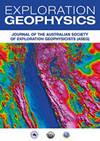稀疏地球物理数据的压缩感知重构:以区域磁学为例
IF 0.8
4区 地球科学
Q4 GEOCHEMISTRY & GEOPHYSICS
引用次数: 0
摘要
离散采样地球物理数据的重建通常通过网格或插值算法完成。这种方法通常考虑局部梯度,在强调小尺度结构的同时,也会引入网格伪影,并修改原始数据的频率特性。在这里,我们研究了压缩传感技术在空间变化的地球物理数据中的潜力,特别是线和网格航空磁数据。我们证明,对于次奈奎斯特采样率,该方法仍然能够重建一个清晰的信号,并证明重建数据的频率表示随着数据采样频率的变化而变化,显示出更稀疏采样的频率范围减小。相反,我们证明了许多广泛的网格化方法人为地将高频信号引入网格化地图中,这些信号在原始和压缩感知重建中都不存在。这表明了传统网格方法在光谱保真度方面的局限性,也表明了压缩感知可能是一种更合适的插值技术的条件-即当数据的真实光谱表示比小规模目标识别具有更高的先例时。本文章由计算机程序翻译,如有差异,请以英文原文为准。
Compressed sensing reconstruction of sparse geophysical data: an example from regional magnetics
Reconstruction of discretely sampled geophysical data is generally done via gridding or interpolant algorithms. Such approaches typically consider local gradients which, while emphasising small-scale structure, can also introduce gridding artefacts, and modify the frequency characteristics of the original data. Here, we examine the potential of compressed sensing techniques for spatially-varying geophysical data, particularly line and gridded aeromagnetic data. We show that for sub-Nyquist sampling rates, the approach is still able to reconstruct a legible signal, and demonstrate the frequency representation of the reconstructed data varies with data sampling frequency, showing a reduced frequency range for sparser sampling. In contrast, we demonstrate that many widespread gridding approaches artificially introduce high-frequency signals into the gridded maps that are not present in the original nor in the compressed sensing reconstructions. This demonstrates the limitations of conventional gridding approaches in spectral fidelity and also suggests the conditions under which compressed sensing may be a more appropriate interpolant technique – namely when authentic spectral representation of the data is of higher precedent than small-scale target identification.
求助全文
通过发布文献求助,成功后即可免费获取论文全文。
去求助
来源期刊

Exploration Geophysics
地学-地球化学与地球物理
CiteScore
2.30
自引率
0.00%
发文量
33
审稿时长
>12 weeks
期刊介绍:
Exploration Geophysics is published on behalf of the Australian Society of Exploration Geophysicists (ASEG), Society of Exploration Geophysics of Japan (SEGJ), and Korean Society of Earth and Exploration Geophysicists (KSEG).
The journal presents significant case histories, advances in data interpretation, and theoretical developments resulting from original research in exploration and applied geophysics. Papers that may have implications for field practice in Australia, even if they report work from other continents, will be welcome. ´Exploration and applied geophysics´ will be interpreted broadly by the editors, so that geotechnical and environmental studies are by no means precluded.
Papers are expected to be of a high standard. Exploration Geophysics uses an international pool of reviewers drawn from industry and academic authorities as selected by the editorial panel.
The journal provides a common meeting ground for geophysicists active in either field studies or basic research.
 求助内容:
求助内容: 应助结果提醒方式:
应助结果提醒方式:


